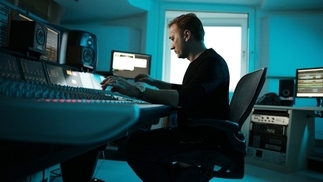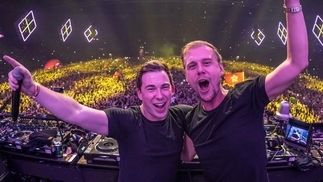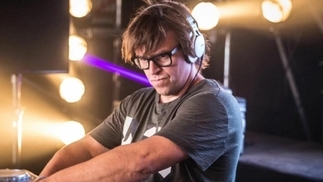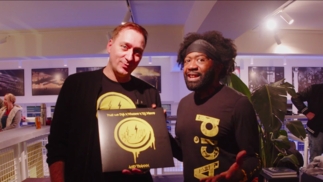Paul van Dyk talks near-death, recovery and the enduring power of trance
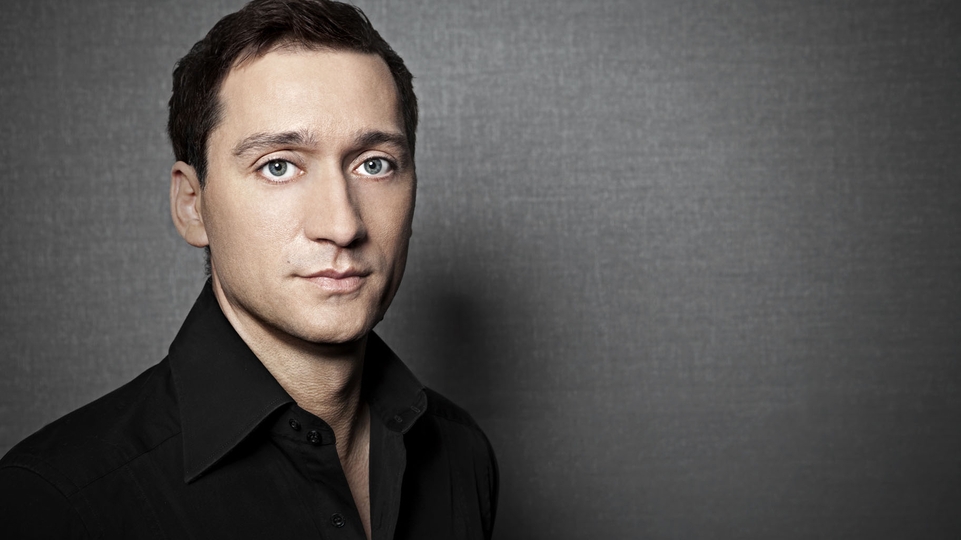
A year-and-a-half after his near-death accident, Paul van Dyk returns to trance stronger than ever, with a new album, new live show, and new perspective afforded to those who have grazed the veil separating this world from the next...
This isn’t your average comeback story. And Paul van Dyk isn’t your average comeback kid. The Grammy-winning German DJ/producer is a legend in his own right, hailed as the man who launched an entire genre: without him, trance music might not be what it is today. Or exist at all. That’s not hyperbole; it’s fact. Paul’s body of work is enshrined in the annals of electronic music history, decorated with awards and showered with critical accolades. A two-time winner of the DJ Mag Top 100 DJs poll, his songs have been played in clubs and on festival stages for over 25 years, but they’re also queued up during weddings and birthdays, marking memories in the minds of more than a generation of ravers. And his harrowing brush with death last year only adds emotional weight to the exquisite music that has emerged in the aftermath of an accident that left him lying comatose in a hospital bed.
Events unfold rapidly in emergencies, like the flutter of camera shutters: roaring crowd, arms outstretched, swirling lights, raised stage, one wrong step, shattered body, fade to black. On the night of February 27th, 2016, Paul van Dyk fell nearly 20 feet through an ill-concealed gap while onstage at the A State Of Trance Festival in Utrecht, Holland. He was immediately airlifted to the nearest hospital, where it was determined that he had fractured his spine in two places, and had sustained severe brain damage. An outpouring of support from across the globe flooded social media channels and music news outlets. Shocked fans replayed the minute-long video of the artist’s fateful misstep, caught on a mobile phone camera: how could this have happened? For a few days, doctors received minimal neurological response when prodding Paul’s broken body. Yet, he was lucky. His vital organs remained unharmed, and although he could not feel his legs when he finally returned to consciousness, he was alive.
‘From Then On’ marks Paul van Dyk’s return to life after a glimpse of the inevitable end we all spend a lifetime avoiding. His first LP in nearly three years and eighth artist album, it is his first release since the accident and without question, his most poignant work to date. True to its title, ‘From Then On’ is a portrait of the fruits of resurrection – resurrection of health, of creative aptitude and of spirit. It is born from the ultimate shift in perspective, afforded to the few who witness the limits of their own fragility. After darkness, light always shines brighter. Paul van Dyk’s struggle to cope with new physical and mental limitations has given him a greater depth of appreciation for each breath. There is joy in standing up, in making coffee, in watching a bird scuttle to the next branch. From that gratitude, beautiful art is born.

CLEAR SKIES
“We have gray moments here, but when it’s sunny it’s really cool,” Paul laughs, gesturing at the sprawling cityscape, as DJ Mag joins him in his Berlin office on an autumn afternoon. Sunlight streams into the room through large windows. The sky is cloudless and blue, a rare event for the European city. Paul is in good spirits, and accepts a cup of coffee from his manager as he settles into his chair for the next hour. He has recently returned from New York City, where he debuted his new, visually-sumptuous live show concept, AEON by Paul van Dyk, at the PlayStation Theater, and he’s prepping for the release of ‘From Then On’ via his own Vandit label in the coming weeks. His eyes glint with satisfaction, and it occurs to us that gratitude is humanity’s most attractive asset. “I have never felt closer to my own music than with this album,” he states, taking a sip of the hot coffee.
Understanding where this music comes from makes the experience of listening to it even more intense. The album carries us into expansive realms of euphoria, bursting with rapid-fire emotion, and it is quintessentially Paul van Dyk. Yet, while it retains the artist’s familiar trance signature – glittering melody, soaring strings, forward-marching kicks – there is something indescribably poignant about it. Each track is meaningful. The song titles reflect his newfound experience, quite literally: ‘I Am Alive’ is redolent of classic late-‘90s trance, a new chance to revisit old roots; ‘Close Call’ is cinematic, sharp and tense, a nod to the knife-edge between life and death; while ‘Stronger Together’ is among the album’s most euphoric cuts, a dramatic tribute to the power of community – without which, Paul van Dyk would not be alive.
When Paul emerged from his comatose state, he was met with a vulnerable new reality. “I couldn’t speak, I couldn’t eat, I couldn’t go to the toilet, I couldn’t do anything. I had to learn it all again. That was a very hard point to understand.” Paul leans forward in his seat, emphasizing the enormity of such a revelation: “Think about it in a bigger philosophical sense – when you’re a little kid and you go to the toilet, and for the first time you do it alone, this is almost what defines you as a human being. Now imagine you’re an adult, and you can’t do this anymore.” Recognizing your own mortality also means witnessing your vulnerability, and while Paul appreciates the new perspective, he says that being aware of his survival has been anything but uplifting: “I can tell you, it’s the total opposite,” he states, unequivocally. “I’m far more living in fear... because I know how quickly things can be over.”

Despite that fear, Paul has focused on the positive in order to heal, and explains that he was the recipient of some fortunate coincidences. Coincidence number one: The accident happened in Utrecht, only a 10 minute drive from the top neurological center in all of Holland. “If the show would have been in Amsterdam, like one and a half hour ride away, I wouldn’t be here talking to you now.” Coincidence number two: One of Europe’s top neurological injury specialists happened to be in the hospital at 5am on Sunday morning, precisely when the ambulance delivered Paul van Dyk through its doors, because of another case. “He was there to take the right steps, rather than some assistant doctor waiting for him to arrive on Monday when it probably would have been too late. I wouldn’t be sitting here,” Paul smiles wryly.
And then there is his wife, Margarita. The first thing she did while her husband laid motionless in bed, with doctors refusing to give any concrete prognosis, was decorate his hospital room with his favorite things: his football club shirts, flowers, photos of the two of them – “so that as soon as I’d wake up, I would have the first bit of memory that connects me to something that is part of me. And these details, that’s what she’s made of as well,” Paul smiles as he recalls her care, and his overwhelming love for her is evident. “She’s just amazing. Really.”

For the first two days after his fall, neurologists tried and failed to elicit a physical response from Paul. Machines showed his brain was still functioning, but his body was unresponsive. It wasn’t until his wife arrived that he stirred. “She touched my fingers, and then she said, ‘Grab my hand.’ And I grabbed her hand while unconscious,” Paul’s green eyes light up as he tells the story, “and she ran out of the room yelling for the doctors to come in and see that I had moved. But I didn’t do it when the nurse came. Just her.”
In retrospect, that moment left a mark on the artist, profoundly changing his worldview. “That’s a clear indication there’s something else,” he states, shaking his head. “I’m a pragmatic person. I don’t believe in God. I’m not an esoteric guy... but this is outside of comprehension for a pragmatic person. There is obviously something like the soul, the inner core. As someone who believes in quantum physics I would say, it’s the Higgs Boson of us. Because I knew, my soul knew, when Margarita grabbed my hand: ‘That’s my girl.’”

STRONGER TOGETHER
The album’s opening track, ‘While You Were Gone’, features an elegant piano arrangement that sounds like an homage to its title – a soul hovering over its earthly body in an astral projection of emotion, reimagined in waveform. But that is not at all what Paul van Dyk had in mind when he wrote it. He doesn’t have a recollection of the first four weeks after his fall, laying in various states of consciousness, first in a Dutch hospital and then a facility in Berlin. The last thing he does remember is leaving his green room and heading towards the stage on that fateful night. “The brain erases a little bit of memory from before [an accident], I don’t even remember playing for the first 20 minutes before I fell,” he admits.
When we share our thoughts on the song, gushing over its etheric otherworldliness, Paul chuckles and says that the reaction is a good example of why people like trance so much. “They always go on and tell me for hours and hours what they love about it. A good piece of music gives you a sketch of the emotional surrounding of the artist. And you then take that in, you make it your own, you fill it with your own experience. Suddenly, it’s not my track anymore – it’s yours.” ‘While You Were Gone’ is filled with the sentiment of Paul van Dyk’s deep appreciation for the woman who brought him back to life with memories and love and care, and whom he says is the best reason for him to still be here.

“A very essential part of me not giving up and fighting for my life, fighting to get better, is my wife. She’s an adventurous type in a very cool way – right now she’s climbing Mount Kilimanjaro!” he boasts with a smile. “At the time I wrote ‘While You Were Gone’, she was hiking the 3 Passes Trek around Mount Everest. I was in Beijing, sitting there feeling alone and detached from the world, and I wrote the song.” The track, co-produced with Vincent Corver, is rich with sentimental melody, but it bursts into a subby, forward-rolling beat three quarters of the way through. Paul reveals that he used a sub bass to make the bass drum kick. “This is why it sounds almost like a heartbeat pumping – ‘boom, boom, boom’,” he thumps his hand against his chest, as if to remind it to keep going.
Since the accident, there has been change: Paul’s DJ sets are no longer three hours, he works more slowly, he can’t properly feel his legs. “It’s almost as if I’m walking on clouds.” There has been pain: “There were times when I was simply in so much pain that I would just burst out in tears. It was just seriously indescribable. They always ask you in the hospital, ‘On a scale of one to 10 how much does it hurt?’ And I was always saying, ‘It’s a 100.’” But there has also been love: “[The doctors and nurses] really gave me the feeling that it mattered. That I matter. That it mattered to them that I try. And all that together with the cards, letters, e-mails, videos, voice messages I got from colleagues, friends and fans – all that positive energy encouraged me. Because even on the hard days, to simply get through was enough.”

‘From Then On’ means more to Paul van Dyk than anything else he has made before. He feels it is his most successful album, simply because he was able to make it. “All the support is what made me pull through. You can’t do something like this alone. It was a joint effort, and I’m here,” he insists. “And the same goes for many other things.” Ironically, in the year and a half since Paul’s accident, he has witnessed a disintegration of communal strength on the global level: our damaged climate precipitates more tribal warfare, the rise of neo-fascism is haunting Europe, a fractured America is divided beyond repair, religious extremism codifies terrorist cells. “My moral standards and my political beliefs are still the same as they were before. But I think what my personal story is a very good example of, is this whole concept of being ‘stronger together’. To be together, to work together, and to solve problems together.”
There is something to be said for the role music plays in connecting people, and it is what Paul van Dyk says inspired his classic 2001 compilation album, ‘The Politics Of Dancing’. Though his politics remain unchanged since the accident, he speaks more passionately about the topic now, having experienced the type of healing that can only be achieved with the help of a large community. “We need to all stick together on these things. We’re all human beings, all responsible for this planet – and when a guy like Trump says he was elected by the people in Pittsburgh not by the people in Paris – you know what, this is fucking bullshit. Because if this planet goes bonkers, then it affects the people in Pittsburgh as much as the people in Paris,” he crosses his arms and sits back in his seat. “We can only solve things together.”

BEYOND THE WALL
Paul van Dyk’s Berlin office sits on the Spree River in the Friedrichshain- Kreuzberg borough, just a few meters from the world-renowned Watergate club and at the nexus of German history. The former East Berlin district of Friedrichshain is connected to the former West Berlin district of Kreuzberg (now reminiscent of New York’s East Village in its counterculture heyday) by the historic Oberbaum Bridge, which was once a Berlin border crossing for pedestrians. Graffiti-covered stone arches stretch from one side of the river bank to the other. Barbed wire and repression have been replaced by nightclubs and kebab shops, skateboarders and artists. Paul remembers what it was once like, because he grew up in East Berlin. “Right over there, actually,” he grins, craning his neck and pointing as he peers out of the window.
The cold, gray drudgery of life in East Berlin is not cinematic overkill, dramatically reimagined by movie directors. It was a place bent on stifling creativity, movement, passion and free will. The absence of art and beauty from East Berlin was intentional, and it meant that 10-year-old Paul van Dyk had to access music in illicit ways. “I was doing my homework, listening to the West Berlin mega stations on my radio – illegally of course, because that was forbidden – when I stopped one day and turned it up and was like, ‘What’s this?’ This music was different, and it connected with me.” The band he heard that day was The Smiths, and it turned Paul van Dyk into a self-professed radio junkie. “We didn’t have record shops or magazines, or anything at all in East Germany.”

Eventually, the sounds of early house music from Chicago and Detroit began filtering through Paul’s pirated radio waves, and by the time the Berlin Wall fell in 1987, he reveled in the clubs. Still, he was searching for something he felt was missing from dance music, a stronger connection and a more profound sensation. “The music I wanted simply didn’t exist, so I had to make it myself.” And while there will always be a debate about the origins of any genre, enough people agree that Paul van Dyk is a significant actor in the saga of trance. Queue up his 1993 remix of Humate’s ‘Love Stimulation’ for a glimpse at the genre’s genesis. The expansive harmonies, layered strings and faster BPM are familiar elements today, but in the early ‘90s, they weren’t the norm.
Although he loves house and techno, Paul believes trance represents “the most complete” form of music; one without boundaries. “With the minimal techno stuff, after five minutes you hit a wall and you’re just like, wow. That doesn’t create a landscape. And this is what I like – I like to see a horizon.
"Techno, to me, is ten meters long and then there’s a wall,” he gestures with his hands, slicing a line through the air. “Trance, on the other hand, is a horizon. You can see the sun going up and down depending on which direction you look and all that is in between, all the experience, everything that happens in the world. Moving towards the horizon is part of trance music.”

There is a track on his new album titled ‘Fairytales’ that is decidedly triumphant, ringing with bliss. And while we don’t ask what it means, we can’t help but imagine a young boy huddled over his small radio, stealing sounds from a world beyond his reach, but within his view. Paul smiles and nods at the window again. He can see his childhood school in the distance, just across the river bank to the east. The irony of literally pushing through a physical wall to get to the music and life he loves, is not lost on him. “When I was sitting in class in school as a kid, I was actually able to look toward the left which was West Berlin. I would look towards the west, look towards the horizon, look towards where I thought freedom and beauty was,” as he speaks, he looks to the west, away from us, unpacking an old memory. “Music and the horizon somehow always had something to do with my craving for freedom and movement, energy and positivity. And I guess, really, it’s still the case.”
and see that I had moved. But I didn’t
do it when the nurse came. Just her.”
In retrospect, that moment left a mark
on the artist, profoundly changing his
worldview. “That’s a clear indication
there’s something else,” he states,
shaking his head. “I’m a pragmatic
person. I don’t believe in God. I’m not
an esoteric guy... but this is outside of
comprehension for a pragmatic
person. There is obviously something
like the soul, the inner core. As
someone who believes in quantum
physics I would say, it’s the Higgs
Boson of us. Because I knew, my soul
knew, when Margarita grabbed my
hand: ‘That’s my girl.’”
STRONGER TOGETHER
The album’s opening track, ‘While You
Were Gone’, features an elegant piano
arrangement that sounds like an
homage to its title – a soul hovering
over its earthly body in an astral
projection of emotion, reimagined in
waveform. But that is not at all what
Paul van Dyk had in mind when he
wrote it. He doesn’t have a
recollection of the first four weeks
after his fall, laying in various states
of consciousness, first in a Dutch
hospital and then a facility in Berlin.
The last thing he does remember is
leaving his green room and heading
towards the stage on that fatefful
night. “The brain erases a little bit of
memory from before [an accident], so
